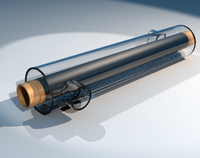
Photo from wikipedia
A rectangular settling tank in full scale is investigated using the Fluent software to increase its efficiency. First, the pure water is simulated in the absence of particles. Then particles… Click to show full abstract
A rectangular settling tank in full scale is investigated using the Fluent software to increase its efficiency. First, the pure water is simulated in the absence of particles. Then particles are injected into the flow field and tracked by means of the discrete phase model. Three methods are presented to optimize the settling tank: (1) adding a baffle which is mounted in the bottom and is extended up to the near of free surface, (2) adding a baffle which is mounted in the free surface and is extended up to the near of the tank bottom and (3) install a bi-directional baffle which is mounted in the free surface and is extended up to the near of the bottom. These three suggestions are checked using the short-circuiting phenomenon and the successful settling theory. The successful settling theory states that a particle can be accounted as a “trapped” particle if (1) settled particle stays static and stable in the tank bottom and (2) settled particle doesn’t return to purified sewage. Although the second method provided higher efficiency, the third method was selected as the most appropriate method in order to optimize the settling tank.
Journal Title: Meccanica
Year Published: 2018
Link to full text (if available)
Share on Social Media: Sign Up to like & get
recommendations!